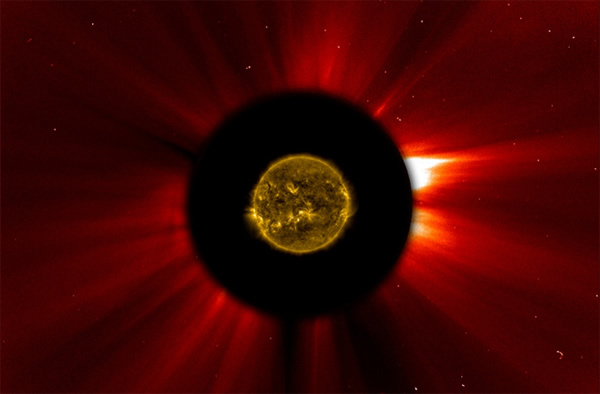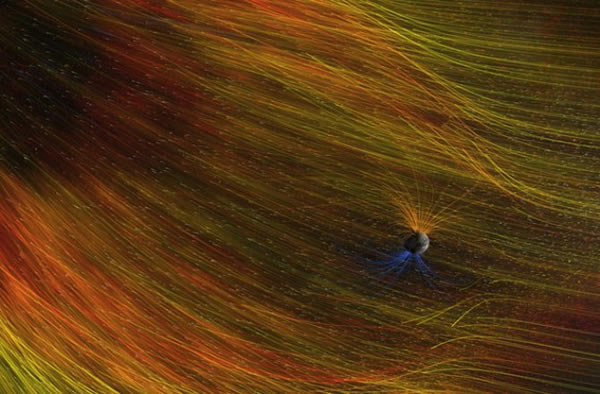The Solar Wind is an Interplanetary Water Factory
The extended solar corona and embedded solar wind as seen by the NASA/ESA Solar and Heliospheric Observatory (SoHO). The solar disk in center is an extreme ultraviolet observation of the lower solar corona by NASA's Solar Dynamics Observatory (SDO).
The Earth is bathed in a constant stream of particles from the solar wind -- could these particles have a role to play in interplanetary water production?
When searching for galaxies to study, it is easiest to pick out the biggest and brightest. This is especially true if you want to look at very distant galaxies; ones that were around when the Comets and asteroids were not the only delivery options for seeding Earth -- and potentially other planets -- with water and organic materials for life.
New research shows hydrogen ions in the solar wind, a ubiquitous stream of particles flowing from the sun, react with oxygen in interplanetary dust grains to form little packets of water.
Scientists have known for some time that interplanetary dust grains, like the comets and asteroids from which they came, contain organic carbon, considered a key building block for life.
But the mechanism for making water in the dust grains’ radiation-beaten edges was unproven until a team of researchers analyzed some samples retrieved from high up in Earth’s atmosphere.
The grains were collected during high-altitude research flights and analyzed in laboratories with an advanced electron microscope that can pick out extremely tiny details. For example, the rims of the interplanetary dust grains where the water was found are about 100 nanometers thick, roughly one-thousandths the width of a human hair.
Researchers are not sure how much solar wind-produced water could have arrived -- and still be arriving -- on Earth.
“There is an enormous number of factors that can play a role,” physicist Hope Ishii, with the University of Hawaii, told Discovery News.
For starters, the amount of radiation coming from the sun has changed over time, as has the amount and sizes of interplanetary dust grains in the solar system.
Heating also plays a role. For example, suspected solar wind-produced water on the surface of the moon varies depending on whether measurements are made in lunar day or night. The water could be escaping into space as temperatures climb, or it could be migrating to colder areas, such as inside permanently shadowed craters in the lunar polar regions.
Though carried out on a much smaller scale, similar solar wind water production in dust grains has some advantages for longevity.
“Because the dust grains are so small, they end up staying very cold so they can actually accumulate water,” Ishii said.
“Quantifying how much water is going to be a challenge, but it’s clear that because the influx of interplanetary dust particles is a continuing process that this can eventually become a significant amount of water just from cumulative buildup,” she said.
“It doesn’t just take a thunderstorm to fill up a lake. A continual light rainfall is also contributing to the water accumulation,” she added.
Potentially more important than how much water could have been produced and delivered by interplanetary dust grains is the organic carbon packaged along with it. Add heat from the dust grains entering Earth's atmosphere and the chemistry for life could begin to brew.
“We have this combination of water and organics being delivered simultaneously and continuously in a small volume where they are able to intermix and act like a little chemical reactor. It can generate compounds that are relevant to life being able to initiate,” Ishii said.
The same process could be happening on any solar system where hydrogen ions are spewing out in stellar winds.
"Water in the rims (of interplanetary dust grains) has implications for the origin of water on airless bodies like the moon and asteroids and delivery of water in other astrophysical environments," notes physicist John Bradley, with the Lawrence Livermore National Laboratory in California, and colleagues in a paper published in this week's Proceedings of the National Academy of Sciences.(Jan 21, 2014 03:00 PM ET // by Irene Klotz)













